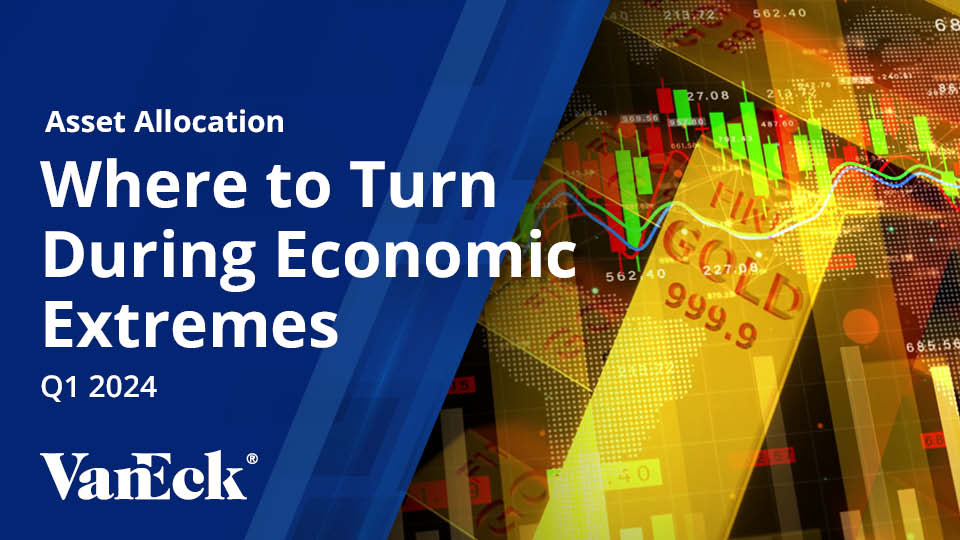RAAX Heats Up on Warming Inflation
May 14, 2021
Read Time 6 MIN
The VanEck Vectors® Real Asset Allocation ETF (RAAX®) uses a data-driven, rules-based process that leverages over 50 indicators (technical, macroeconomic and fundamental, commodity price, and sentiment) to allocate across 12 individual real asset segments in five broad real asset sectors. These objective indicators identify the segments with positive expected returns. Then, using correlation and volatility, an optimization process determines the weight to these segments with the goal of creating a portfolio with maximum diversification while reducing risk. The expanded PDF version of this commentary can be downloaded here.
Overview
The VanEck Vectors® Real Asset Allocation ETF (“RAAX”) returned +3.92% versus +8.29% for the Bloomberg Commodity Index. RAAX is up 12.49% year-to-date as real assets continue to benefit from the threats of higher inflation and the overall strength of the economy. Last month, the income assets returned +6.44%, the resource assets returned +3.88% and the financial assets returned +1.98%.
Inflation is heating up. Warren Buffet, at his annual shareholder meeting on May 1, said, “We are seeing very substantial inflation. We are raising prices. People are raising prices to us and it’s being accepted.” The latest year-over-year inflation change, as of March 31, based on the Consumer Price Index (“CPI”), was 2.6%. The March change in CPI was 0.60%. Looking back at the last 10 years, the monthly change represents a two standard deviation event, which is expected to occur about once every 3 years. In fact, the last time we had a monthly reading this high was in 2012. The change in CPI in February was also reasonably high at 0.40%. Another sign that inflationary forces are building came from the 1% gain in Producer Price Index (“PPI”), which was double what economists expected. PPI is considered a leading indicator of CPI because producers look to pass costs on to consumers.
Commodity prices are another leading indicator of inflation. In April, commodities were up significantly and were the largest individual contributor to performance within RAAX. The rally in commodity prices was broad, which further indicates that prices, in aggregate, are rising. The Bloomberg Energy Index was up 7.07%, the Bloomberg Agriculture Index was up 13.36%, the Bloomberg Industrial Metals Index was up 8.82% and gold was up 3.60%.
This month’s allocation to resource assets is 47.3%, to income assets is 30.3% and to financial assets is 22.3%.
RAAX Asset Allocation Across Financial, Income, and Resource Assets
(as of May 1, 2021)
Source: VanEck.
Performance Review
The largest contributors to performance, from largest to smallest, were income assets with a return of +6.44%, resource assets with a return of +3.88% and financial assets, with a return of +1.98%.
Total Return Contribution (April 2021)
Data as of April 30, 2021. Source: FactSet. Past performance does not guarantee future results. Please see index descriptions in Disclosure.
The income-producing assets, in aggregate, returned +6.44% in April and +17.73% year-to-date. The current yield of this allocation, based on 12-month yields, is 2.81%. In general, higher yielding assets benefited from the pullback in interest rates in April. The yield on the U.S. 10-Year Treasury Index started the month at 1.74% and fell as low as 1.54% mid-month, finishing the month at 1.63%. Of these assets, REITs was RAAX’s top performing position with a return of +7.86%, followed by MLPs with a return of +5.30%, and infrastructure with a return of +3.48%.
RAAX increased its allocation to infrastructure this month with a 5% allocation to U.S. infrastructure. This includes companies that stand to benefit from an increase in the production of raw materials, heavy equipment, engineering and construction within the U.S. The outlook for these companies has improved significantly due to President Joe Biden’s $2.3 trillion plan to broadly upgrade the infrastructure of the country.
Income Assets: Total Return and Contribution (April 2021)
Data as of April 30, 2021. Source: FactSet. Past performance does not guarantee future results. Please see index descriptions in Disclosure.
The resource assets segment of the portfolio returned +3.88% in April and +18.63% year-to-date. RAAX’s top performing resource allocation was commodities with a return of +8.09%. The broad rally in commodity prices was supported by strong economic data, a weak U.S. dollar and expectations of an uptick in economic activity.
RAAX’s investments in natural resource equities returned +1.03%. The top performing natural resource equity investments were in base metals equities with an aggregate return of +7.33%, followed by agribusiness companies with a return of +4.22%. RAAX’s allocation to oil related equities, returning -0.52%, cooled down this month despite WTI crude oil being up 6.69%. A modest pullback in the prices of energy equities represents a healthy pause in an allocation that has returned +31.17% year-to-date.
Sustainable energy has been one of the few sore spots in the portfolio this year, which continued in April. RAAX’s investments in sustainable energy were down -3.47% in April and down -8.33% year-to-date. Equity prices for companies in the sustainable energy industry, after generating tremendous performance last year, continues to correct due to the markets transition away from aggressive growth companies and towards companies with more economic sensitivity. We reduced our exposure to clean energy from 7% to 5%, and further diversified our clean energy allocation by adding more exposure to solar, semiconductors that support clean energy and domestic companies.
Resource Assets: Total Return and Contribution (April 2021)
Data as of April 30, 2021. Source: FactSet. Past performance does not guarantee future results. Please see index descriptions in Disclosure.
Financial Assets
The financial assets, in aggregate, returned +1.98%, but are still down -3.11% year-to-date. This month, our financial asset segment of the portfolio was led higher by gold prices. RAAX’s allocation to gold bullion returned +3.56% and gold equities returned +5.72%. Gold prices were supported by the falling U.S. dollar. Our allocation to gold is down -6.46% year-to-date as optimism has grown over the re-opening of the economy. However, the recent positive price action in gold may be an indication that the market is growing concerned about the aggressive monetary and fiscal policies that have led the markets higher as well as the threat of inflation.
RAAX’s exposure to bitcoin was a detractor from performance with a return of -6.37%. The price of bitcoin started the month at $58,690 and reached a high of $63,410 mid-month with the IPO of Coinbase, the popular cryptocurrency platform. The price of bitcoin fell to $48,122 on President Biden’s proposal to increase the long-term capital gains tax rate from 20% to 39.6% for those who make over $1 million in annual income. This news prompted a rush to sell assets with the highest gains, and it is hard to find other assets with returns higher than bitcoin.
We first started accumulating exposure to bitcoin when it was priced at $33,664 and in the short period since then we have experienced a rapid surge in prices. The price of bitcoin was $56,814 at the end of the month.
Financial Assets: Total Return and Contribution (April 2021)
Data as of April 30, 2021. Source: FactSet. Past performance does not guarantee future results. Please see index descriptions in Disclosure.
The table below demonstrates the current and previous month’s asset allocation for RAAX. The changes include: financial assets decreased due to a 3% reduction from gold bullion, income assets increased due to a 5% increase in U.S. infrastructure and resource assets decreased due to a 2% reduction clean energy, a 1% reduction in commodities and a 1% increases in base metals.
Monthly Asset Class Changes
| May-21 | Apr-21 | Change | |
| Financial Assets | 22.3% | 25.5% | -3.2% |
| Bitcoin | 4.5% | 5.0% | -0.5% |
| Gold Equities | 4.5% | 4.4% | 0.1% |
| Gold Bullion | 13.2% | 16.2% | -3.0% |
| Income Assets | 30.2% | 24.2% | 6.0% |
| REITs | 14.9% | 14.5% | 0.3% |
| MLPs | 5.6% | 5.6% | 0.1% |
| Global Infrastructure | 9.8% | 4.8% | 5.0% |
| Resource Assets | 47.3% | 50.3% | -3.0% |
| Low Carbon Energy Equities | 4.9% | 7.5% | -2.7% |
| Diversified Commodities | 19.7% | 19.9% | -0.2% |
| Global Metals & Mining Equities | 3.3% | 2.6% | 0.7% |
| Steel Equities | 3.5% | 2.8% | 0.7% |
| Unconventional Oil & Gas Equities | 3.4% | 3.6% | -0.1% |
| Oil Services Equities | 3.0% | 3.2% | -0.2% |
| Energy Equities | 4.4% | 4.5% | -0.1% |
| Agribusiness Equities | 5.2% | 5.1% | 0.1% |
| Cash | 0.1% | 0.2% | 0.0% |
Source: VanEck.
The chart below shows the real asset risk composite that measures extreme risk within real assets using various quantitative signals. The current score is 4, which indicates a stable risk regime for real assets.
Source: VanEck.
April was another great month for investors in real assets and RAAX. Real assets have been a top performing segment of the market for the past six months and, given the inflation risks and pickup in economic activity, we believe that the trend will continue.
Related Topics
Related Insights
February 28, 2024
February 22, 2024
December 19, 2023
DISCLOSURES
Please note that the information herein represents the opinion of the author, but not necessarily those of VanEck, and these opinions may change at any time and from time to time. Non-VanEck proprietary information contained herein has been obtained from sources believed to be reliable, but not guaranteed. Not intended to be a forecast of future events, a guarantee of future results or investment advice. Historical performance is not indicative of future results. Current data may differ from data quoted. Any graphs shown herein are for illustrative purposes only. No part of this material may be reproduced in any form, or referred to in any other publication, without express written permission of VanEck.
This content is published in the United States for residents of specified countries. Investors are subject to securities and tax regulations within their applicable jurisdictions that are not addressed on this content. Nothing in this content should be considered a solicitation to buy or an offer to sell shares of any investment in any jurisdiction where the offer or solicitation would be unlawful under the securities laws of such jurisdiction, nor is it intended as investment, tax, financial, or legal advice. Investors should seek such professional advice for their particular situation and jurisdiction.
The MVIS Global Agribusiness Index is a modified market cap-weighted index tracks the performance of the largest and most liquid companies in the global agribusiness segment. Its unique pure-play approach requires that companies have to generate at least 50% of their revenues from agri-chemicals and fertilizers, seeds and traits, from farm/irrigation equipment and farm machinery, from agricultural products (incl. Grain, tobacco, meat, poultry and sugar), aquaculture and fishing, livestock, plantations and trading of agricultural products. The MVIS Global Coal Index is a modified market cap-weighted index tracks the performance of the largest and most liquid companies in the global coal segment. Its unique pure-play approach requires that companies have to generate at least 50% of their revenues from coal operation (production, mining and cokeries), transportation of coal, from production of coal mining equipment as well as from storage and trade. The NYSE Arca Gold Miners Index is a modified market capitalization-weighted index composed of publicly traded companies involved primarily in the mining for gold. The Index is calculated and maintained by the New York Stock Exchange. The MVIS U.S. Listed Oil Services 25 Index is intended to track the overall performance of U.S.-listed companies involved in oil services to the upstream oil sector, which include oil equipment, oil services, or oil drilling. The MVIS Global Unconventional Oil & Gas Index is intended to track the performance of the largest and most liquid companies in the unconventional oil and gas segment. The pure-play index contains only companies that generate at least 50% of their revenues from unconventional oil and gas which is defined as coal bed methane (CBM), coal seam gas (CSG), shale oil, shale gas, tight natural gas, tight oil and tight sands. The DBIQ Optimum Yield Diversified Commodity Index Excess Return is an index composed of futures contracts on 14 heavily traded commodities across the energy, precious metals, industrial metals and agriculture sectors. The NYSE Arca Steel Index is a modified market capitalization weighted index comprised of publicly traded companies involved primarily in the production of steel products. The S&P Global Infrastructure Index is designed to track companies from around the world chosen to represent the listed infrastructure industry while maintaining liquidity and tradability. To create diversified exposure, the index includes three distinct infrastructure clusters: energy, transportation, and utilities. The MVIS Global Low Carbon Energy Index (MVSMOGTR) is a rules based index intended to track the overall performance of renewable energy companies which may include, but is not limited to: wind, solar, hydro, hydrogen, bio-fuel or geothermal technology, lithium-ion batteries, electric vehicles and related equipment, waste-to-energy production, smart grid technologies, or building or industrial materials that reduce carbon emissions or energy consumption.
Any indices listed are unmanaged indices and include the reinvestment of all dividends, but do not reflect the payment of transaction costs, advisory fees or expenses that are associated with an investment in the Fund. Certain indices may take into account withholding taxes. An index’s performance is not illustrative of the Fund’s performance. Indices are not securities in which investments can be made.
An investment in the Fund may be subject to risks which include, among others, in fund of funds risk which may subject the Fund to investing in commodities, gold, natural resources companies, MLPs, real estate sector, infrastructure, equities securities, small- and medium-capitalization companies, foreign securities, emerging market issuers, foreign currency, credit, interest rate, call and concentration risks, derivatives, cryptocurrency, cryptocurrency tax, all of which may adversely affect the Fund. The Fund may also be subject to affiliated fund, U.S. Treasury Bills, subsidiary investment, commodity regulatory (with respect to investments in the Subsidiary), tax (with respect to investments in the Subsidiary), risks of ETPs, liquidity, gap, cash transactions, high portfolio turnover, model and data, management, operational, authorized participant concentration, no guarantee of active trading market, trading issues, market, fund shares trading, premium/discount and liquidity of fund shares, and non-diversified risks. Foreign investments are subject to risks, which include changes in economic and political conditions, foreign currency fluctuations, changes in foreign regulations, and changes in currency exchange rates which may negatively impact the Fund’s returns. Small- and medium-capitalization companies may be subject to elevated risks.
Diversification does not assure a profit or protect against a loss.
Investing involves substantial risk and high volatility, including possible loss of principal. Bonds and bond funds will decrease in value as interest rates rise. An investor should consider the investment objective, risks, charges and expenses of the Fund carefully before investing. To obtain a prospectus and summary prospectus, which contain this and other information, call 800.826.2333 or visit vaneck.com. Please read the prospectus and summary prospectus carefully before investing.
© VanEck.
Related Funds
DISCLOSURES
Please note that the information herein represents the opinion of the author, but not necessarily those of VanEck, and these opinions may change at any time and from time to time. Non-VanEck proprietary information contained herein has been obtained from sources believed to be reliable, but not guaranteed. Not intended to be a forecast of future events, a guarantee of future results or investment advice. Historical performance is not indicative of future results. Current data may differ from data quoted. Any graphs shown herein are for illustrative purposes only. No part of this material may be reproduced in any form, or referred to in any other publication, without express written permission of VanEck.
This content is published in the United States for residents of specified countries. Investors are subject to securities and tax regulations within their applicable jurisdictions that are not addressed on this content. Nothing in this content should be considered a solicitation to buy or an offer to sell shares of any investment in any jurisdiction where the offer or solicitation would be unlawful under the securities laws of such jurisdiction, nor is it intended as investment, tax, financial, or legal advice. Investors should seek such professional advice for their particular situation and jurisdiction.
The MVIS Global Agribusiness Index is a modified market cap-weighted index tracks the performance of the largest and most liquid companies in the global agribusiness segment. Its unique pure-play approach requires that companies have to generate at least 50% of their revenues from agri-chemicals and fertilizers, seeds and traits, from farm/irrigation equipment and farm machinery, from agricultural products (incl. Grain, tobacco, meat, poultry and sugar), aquaculture and fishing, livestock, plantations and trading of agricultural products. The MVIS Global Coal Index is a modified market cap-weighted index tracks the performance of the largest and most liquid companies in the global coal segment. Its unique pure-play approach requires that companies have to generate at least 50% of their revenues from coal operation (production, mining and cokeries), transportation of coal, from production of coal mining equipment as well as from storage and trade. The NYSE Arca Gold Miners Index is a modified market capitalization-weighted index composed of publicly traded companies involved primarily in the mining for gold. The Index is calculated and maintained by the New York Stock Exchange. The MVIS U.S. Listed Oil Services 25 Index is intended to track the overall performance of U.S.-listed companies involved in oil services to the upstream oil sector, which include oil equipment, oil services, or oil drilling. The MVIS Global Unconventional Oil & Gas Index is intended to track the performance of the largest and most liquid companies in the unconventional oil and gas segment. The pure-play index contains only companies that generate at least 50% of their revenues from unconventional oil and gas which is defined as coal bed methane (CBM), coal seam gas (CSG), shale oil, shale gas, tight natural gas, tight oil and tight sands. The DBIQ Optimum Yield Diversified Commodity Index Excess Return is an index composed of futures contracts on 14 heavily traded commodities across the energy, precious metals, industrial metals and agriculture sectors. The NYSE Arca Steel Index is a modified market capitalization weighted index comprised of publicly traded companies involved primarily in the production of steel products. The S&P Global Infrastructure Index is designed to track companies from around the world chosen to represent the listed infrastructure industry while maintaining liquidity and tradability. To create diversified exposure, the index includes three distinct infrastructure clusters: energy, transportation, and utilities. The MVIS Global Low Carbon Energy Index (MVSMOGTR) is a rules based index intended to track the overall performance of renewable energy companies which may include, but is not limited to: wind, solar, hydro, hydrogen, bio-fuel or geothermal technology, lithium-ion batteries, electric vehicles and related equipment, waste-to-energy production, smart grid technologies, or building or industrial materials that reduce carbon emissions or energy consumption.
Any indices listed are unmanaged indices and include the reinvestment of all dividends, but do not reflect the payment of transaction costs, advisory fees or expenses that are associated with an investment in the Fund. Certain indices may take into account withholding taxes. An index’s performance is not illustrative of the Fund’s performance. Indices are not securities in which investments can be made.
An investment in the Fund may be subject to risks which include, among others, in fund of funds risk which may subject the Fund to investing in commodities, gold, natural resources companies, MLPs, real estate sector, infrastructure, equities securities, small- and medium-capitalization companies, foreign securities, emerging market issuers, foreign currency, credit, interest rate, call and concentration risks, derivatives, cryptocurrency, cryptocurrency tax, all of which may adversely affect the Fund. The Fund may also be subject to affiliated fund, U.S. Treasury Bills, subsidiary investment, commodity regulatory (with respect to investments in the Subsidiary), tax (with respect to investments in the Subsidiary), risks of ETPs, liquidity, gap, cash transactions, high portfolio turnover, model and data, management, operational, authorized participant concentration, no guarantee of active trading market, trading issues, market, fund shares trading, premium/discount and liquidity of fund shares, and non-diversified risks. Foreign investments are subject to risks, which include changes in economic and political conditions, foreign currency fluctuations, changes in foreign regulations, and changes in currency exchange rates which may negatively impact the Fund’s returns. Small- and medium-capitalization companies may be subject to elevated risks.
Diversification does not assure a profit or protect against a loss.
Investing involves substantial risk and high volatility, including possible loss of principal. Bonds and bond funds will decrease in value as interest rates rise. An investor should consider the investment objective, risks, charges and expenses of the Fund carefully before investing. To obtain a prospectus and summary prospectus, which contain this and other information, call 800.826.2333 or visit vaneck.com. Please read the prospectus and summary prospectus carefully before investing.
© VanEck.



